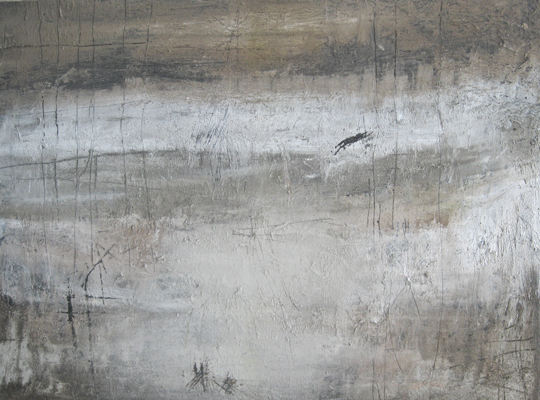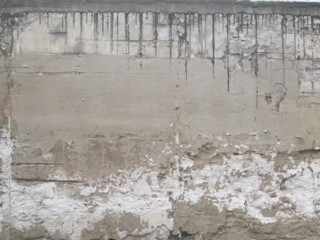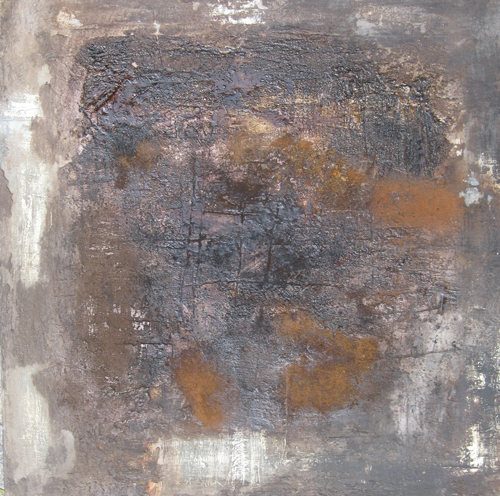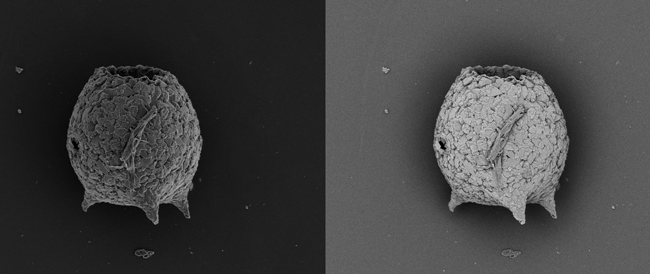Gabriel Lalonde: Who am I? I am first of all earthen, attached to my human status. Telluric, rooted in the Earth. I: artist-poet, poet-artist. Artist and poet, I paint and write. I write words and images. Art inhabits me and is the domain where I have chosen to live. From metal to wood, canvas to paper, I paint, assemble, and sculpt materials, new or recycled. My works speak of time, human traces, and speech of every type.

Barcelone: Les murs / Barcelona: The Walls, 2014, Pigments, dirt, ash, plaster, acrylic paint, binder on canvas, 76 x 102 cm. Courtesy the artist.
My visual and poetic creations consist of a daily and endless peregrination. I address myself primarily and the other indirectly. I speak of art, being, and life. My words and gestures remake and repeat the same work. Continually, along different trajectories. All I do is interrogate the status of the ‘already complete,’ sometimes taking it apart, so as to recompose it according to mutations in time, gesture, and form. I create ideas and transform them into images; I bestow life and revelation upon them. I give life. A new apparition resurrected within the alterity of the object; a return to primal signs and to the first word.
Gleaner of rust
Collector of dead trees
Archivist of bird bones
Excavator of crushed animal carcasses
Culinarian of pickled Barbies
Clincher of cats on the roof of your epidermis
Maker of rocks with heads as masks
Trapper of the illegible
Plasterer of the non-functional
Explorer of marine dirt
Exhumer of past loves
Seducer of snow, whisperer of the full moon
Mirror thief of lips that make you undress
Wedger of fingers between your breasts
Argonaut of paper fish
Benefactor of frissons
Barer of forgotten words
Language of poets
Photographer of scattered wisps of hair
Screamer of souls without country
Sculptor of the heartbeats of heedless mummies
Prospector for the white earth of your skin
Horologist of wind needles
Obstetrician for the loves of the drowned
Wader of your throat
I mate fire boats
With the melancholy of a cello
Gregory Minissale: We are mysteriously drawn towards these works – a lot of it is guesswork, given that I am not responding to the textures, as I can only imagine them from digital images. But maybe it is because I am attracted to earthy tones as opposed to the bright colors that many other artists favor, they seem to release their secrets slowly rather than require a quick response. Why are you attracted to earthy tones, or maybe you aren’t?
GL: My palette is often that of the earth. Often, but not always. For over a decade earth tones have transported me farther. As a terrestrian I always return to the pigment of earth – to this burnt canvas of the human soul. l affirm black, grey, white, and brown colors. And in so doing, I affirm the importance of our passage on earth. I blend sand, earth, ash, and cement. I am drawn to these colors because I am part of this earth and will return to the earth. In the palm of my hand are dead leaves, pulverized bones, and dirt; I wear a hat of earth. I give birth to the rise of a species.
GM: Do you like the associations that someone interested in art might have with earth, prehistorical caves, and walls?
GL: I consider myself neo-archaic. I retreat into signs, traces, and marks – to the primeval and archetypal line. Primitivist, in the sense of the raw, marks, lacerations, lines, silhouettes, scrawls, masks; the taste of earth, wood, bronze, and natural pigments. The recess of my hand holds the gestures of grey, ochre, sepia, nut stain, and the antelope’s shade of brown. Primitivist in the sense of an anchoring to life and nascence: the regeneration toward something new. An archetypal art – of materiality – that is in the process of recovering its genetic code, its primary drives, its ancestral territories.

Les eaux renversées: de la beauté de l’inutile / Spilt Waters: Aesthetics of the Useless, 2013, Ink, acrylic on unprimed canvas, 91 x 71 cm. Courtesy the artist.
GM: …how about with decay?
GL: I work within wabi-sabi aesthetics; it therefore comes as no surprise that my artworks relate to elements of decrepitude, deterioration, and the attrition of things. I assemble debris (rusted materials, construction trash, objects found in the street, empty beer cans, etc.) in the absence of preconceived associations, buildup, or methodology, so as to resubmit it to the reality of matter. What appear then are unusual combinations bearing denatured points of reference. An acclamation to the imperfect. I go from one labyrinth to another, so as to offer the viewer several readings. On the same question of decay, I cannot put it better than the curator Astarte Rowe, who, in writing about my work for her exhibition The Amoebic Workshop (Toronto, 2016), expressed the following:
A perfectly articulated intertextuality acts as the hinge between [Lalonde’s] multi-media images, sculptures, installations, and his published poetic works. His canvases – composed of found materials such as wood debris and clapboard, chairs, empty cans, Barbies, metal, and roof shingles – serve as explorations into the syntax of lost time, eroded existence, faded amorousness, and the general effects of wear and tear. Paintings often attest to the dematerialization of ‘text’ as the signifier of civilized society, and are reminiscent of the Symbolist graffiti, and scribbled calligraphy, of Cy Twombly. Lalonde recuperates and recycles the overspill of speech, religious discourse, and words – processing the detritus of what Ferdinand de Saussure distinguished as la parole into abstract imagery pertaining to the structure of la langue. In this sense, Lalonde’s art is a factory for the disassembly of verse into semiotic ‘units,’ ‘traces,’ ‘marks,’ and ‘lines,’ which become archeological remainders of the poetic.
GM: In his essay on the exhibition Destroy the Picture: Painting the Void 1949-1962 (MOCA LA, 2013), Robert Storr argues that postwar European abstraction was less invested in the clean ‘opticality’ of modernism and American-type painting, and more interested in tactility and the abject. On this view, Art Informel (although this term is contested even by those associated with this tradition) was not only a formal experiment in art history – against cognitive form – but also a psychological working out of trauma and the will to paint. Does any of this strike a chord with you?
GL: I don’t ask myself questions. When I begin working on a piece, I perceive neither its origin nor its conclusion. I begin and I go on. I don’t wait for inspiration. I embody the gesture, line, and form – these succeed me. Artwork comes from respiration; it is executed by the gesture of a hand. The artwork exits me and from the eye I enter it. The eye guides; it connects breath and brain to hand. The artist decides. The artist signs and the piece becomes an artwork. Art hails from everything. I say what I say. I see what I see. I paint what I cannot see. Art creates what is not. A sort of creative impulse forces me (perpetually unsatisfied that I am) to write, construct images, speak to myself about you and me. Of necessity and of appetite. Impelled by the urgency of being in this finite stretch of life.
The artwork already exists. In the past, present, and within me. At the aperture of breath and movement; awaiting to become. The simple anticipation of being born. Gesture, form, matter, error, chance, the eye closed or open – these are the avenues for animating the unknown contemporary, already within me. The point of departure is already there, latent to my internal void. I trace the breath that precedes its expression.
I work with every material that enables me to construct an artwork. With new, used, recycled, and found materials. Ink, oil, acrylic, natural pigments, ash, sand, cement, wood, newspaper, wire, rusted metal, glue, and old cloth. On canvas, wood, paper, cardboard, metal. Same for my tools. Brushes, spatulas, fingers, from left to right hand and vice versa. Found or invented tools; plants; cloth, paper, and metal ends. I work instinctively, rapidly, using gestures and touch. Without a plan or sketches. I apply, remove, construct, deconstruct, glue, unglue, sand, tear up. Make, undo, redo, repeat. I proceed without certitude. I don’t look for anything precise or determined. I give birth to the rise of a species.
GM: Perhaps you could tell us more about the images in this document and any others in the series. What were you feeling/thinking/trying to do with these works?
GL: When I travel, I take photographs of debris, old dilapidated walls, waste, ruins, and dirt. For over twenty years I have created different series based on these photographs. Barcelona: The Walls (2014) is based on a photograph I took in that city in the spring of 2014, and on a poem I wrote a year earlier:
I write walls
in vertical words
Walls of dirtied water
Wrinkled walls
Transplanted
Trespassed
Scratched
by trickled cement
Sullied
Burnished here and there by grey cinders
Broken walls
undone
stooped
cracked
like the shadow of man

Barcelona, 2014. Photograph. Courtesy the artist.
For the series dealing with eroded time and wear, such as Nascent Matter (2014), I rebuild a new earth – living and yet reborn differently – from ash and pigments of rust. I rebuild an internal landscape by painting earth before and after itself. I open the doors of time, I enter another world.
As with Stygian Landscape (2011), I make hundreds of studies on black: in ink, acrylic, and oil. Blind, whether with eyes shut or open. From left to write hand. Using a small piece of wood, an old feather, lead pencil, knife, spatula, a piece of newspaper, a finger. I like the color black. In fact I like black in its multiple renditions. The transparency of black when one barely opens a window; the various shades of black. The black that I sense, and that I flee. The black I create, my hands full of night water. Tenebrous poets and my dark poems that unlock the color black. I transform obsidian into moonlight. The darkness in roots, grain, in the hollow of a nest. Black replaces the memory of the sun.

Paysage noir (recherche pour la suite noir de noir) / Stygian Landscape (study for Black of Black series), 2011, Pigments, paper, cloth, ash, sand, acrylic, binder on canvas, 15 x 15 cm. Courtesy the artist.
Spilt Waters: Aesthetics of the Useless (2013) is a study on raw cotton canvas, unprimed, unstretched and placed on the floor, where chance encounters creation. Part of the work is conducted blindfolded, with hardly any retouches. The title references an incident that took place during the fifth gesture, where I accidentally spilled dirtied water onto the canvas. I let it dry and all I did the next day was add some calligraphic marks to the piece.
We wander towards a prevailing misery, bearing within each of us the muted pain of being alive. Even the earth possesses a faded taste for vagrancy. As with Dark Advance (2015), we march in single file into the dark. Our steps mimic those that came before us. As leaves burgeon, we fall. And always we march ahead. Winter matures, and before us our shadows lengthen.
GM: We like the ‘calligraphic’ elements in your works that are not-quite-calligraphic, ‘accidental’ calligraphy, marks that could be semiotic but maybe not entirely ‘asemiotic’ – they remind me of Robert Morris’ Blind Time Paintings (1973-2009). I like the idea that the viewer has to ‘look into the dark’ in order to ‘read’ the works, to touch the textures like braille; in order to enjoy the darkness and materiality. There is almost a cool texture to the works, but also the sensation of burnt embers.

Matière naissante / Nascent Matter, 2014, Pigments, ash, rust, dirt, acrylic paint, binder on canvas,
51 x 51 cm. Courtesy the artist.
GL: It is as a painter that I ‘write’ on canvas, paper, wood, and other supports. As a painter I invent signs, codes, and de-textuality (désécriture). Seduced by the materiality of words that morph into sentences, I search for their essence, figurative nature, and impulse. I continually invent and reinvent a new language. Through the imprint of our human speech and silences, I write images. I transgress the limits of writing – transforming it into a plastic articulation bereft of intelligence and legibility. I search for sign unmoored from the signified. I deconstruct the written, and exploit its waste through processes of laceration, alteration, and erosion or wear. In making and remaking, I redirect its primary nature. Calligraphic traces are to be found everywhere in my work.
Transformed and stripped of its originary readability, writing is erased, conventions implode. The gaze, destabilized, is forced to forego its points of reference. The artwork thus lends itself to another type of reading; the artwork abnegates linearity, habit, common sense. The viewer is invited to adopt a third approach – different from the first two – wherein the only thing that holds is their perception and subjective hermeneutics, guided by my gesture.
Through my signs, glyphs, and real or imaginary codes – between the signified and non-signified – an entire choreography of the performative emerges, becomes art. The semiotic devolves into the asemiotic. Writing is decoupled from its codified sense, shattering orthodoxy. The signified is quarantined, and all that remains is movement. My artistic interventions liberate the letter, word, and sentence of their intrinsic essence, alienating them from themselves. I invent a writing at the threshold of the tracing of a line, of which all that survives is pure respiration revealed as image.

Mediolus corona, 2011, Scanning Electron Microscope, 150 microns, Bell’s Lake, Toronto. Courtesy Patterson Research Group, Carleton University.
GM: Isn’t it odd that the association with the end of history, of human kind is also a tradition of making art, a tradition of making history (Dubuffet, Fautrier, Kiefer, Dirt Art)? Excavation of lost language. I wonder if there is something of a dark precursor or Cassandra complex in this, which would require that artists be attuned to visions, even if obscure ones, peut-être…
GL:
Merchant of the dark
Of black owls
Of atramental faces composed of raw flesh
Of ghosts
Of black moon
Inverted beneath the bed
Of shadows
In clusters of blackbirds
Black of shrapnel
Of eternity
Gateway to calamity
Stellar peels
Black sap
In smears of dark holes
In obscurity
Black singe
Of being.
Art enters from the back door. Its arrival is of tomorrow. It opens up a passage onto the inaccessible. It is a surpassing that takes the artist beyond himself. And the artist is a radar for what is to come. That which I perceive is transposed into my work. I absorb what surrounds me and release it as transformed material that troubles and seizes one. The artist speaks of ontological vulnerability, and the finite stretch of time.

Marche noire / Dark Advance, 2015, Mixed media on canvas, cement, sand, ash, pigments,
rust, acrylic, glue, 51 x 41 cm. Courtesy the artist.
I sometimes have the feeling that I create works located beyond and before my own time, in advance of myself, works that surpass me and that I come to understand – if at all – a few years later. Darkness springs forth from me, from the gaze I direct at myself or cast upon humans. It comes as well from my interpretation of things, and from those that surround me. I speak of muzzled silences, repressed cries, and the forgotten soul. I speak of the trauma of being, of the enclosure that atrophies. I ratify our impermanence. With these echoes placed at the tips of my fingers, I sculpt shadows – fracturing and decelerating them.
I bear words. I speak of life that passes through me. I create works that shelter shadows, signs, ashen and cindered words – despite which one may find light. To this universe that venerates the ephemeral and the futile, which redacts death, I offer a cure by blackness, by ash, by shadow and obscurity. To soothe fears, I construct an unknown land situated between the lips of time. In this pilgrimage of silence, the gesture is my word. In a deaf and blind world in which the artist’s word takes on its fullest significance, I am neither prophet nor oracle, but he who opens up a fissure in the portal of our age.
Translated from the French by Astarte Rowe
Gabriel Lalonde (b. 1945) is a prolific poet and self-taught visual artist who lives and works in Coteau-du-Lac, Québec. Lalonde has exhibited widely in galleries, art fairs, and exhibitions in Europe and North America.
Greg Minissale is an art historian with wide ranging interests in critical theory, psychology and postcolonial studies. He is author of Framing Consciousness in Art: Transcultural Perspectives (Rodopi: 2009) and The Psychology of Contemporary Art (Cambridge: Cambridge University Press, 2013). Greg is currently senior lecturer in contemporary art and theory at the University of Auckland.